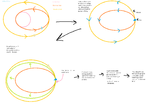Tutorial: Advanced Orbiting/ja
Contents
ホーマン軌道
ホーマン軌道は、周回軌道において軌道傾斜角をキープしながら高度を変更するときに最も使われる方式。遷移後もおなじ天体に留まるため、たとえばカービンからムンのような天体間移動の初期段階でよく使われる。
ホーマン軌道はまず楕円軌道をとる。目標高度に到達したら、つづけて円軌道化をおこなう。つまり合計2回の噴射があるため高TWRエンジンを使用するのが理想的といえる。低TWRエンジンでは遷移するのに40%多くのΔvが必要となり、ApやPeよりも効率のよくない段階から早めに噴射開始しなければならない。
低高度⇢高高度の遷移軌道:
- Pe(近点)で順行方向に噴射し、Ap(遠点)が目標高度に達するまで行う
- 上昇したAp(遠点)に着いたら逆行方向に噴射。Pe(近点)が目標高度に達するまで行う
高高度⇢低高度の遷移軌道:
- Ap(遠点)で逆行方向に噴射し、Pe(近点)が目標高度に達するまで行う
- 下降したPe(近点)に着いたら逆行方向に噴射。Ap(遠点)が目標高度に達するまで行う
二重楕円遷移
- → 参照: Bi-elliptic transfer on Wikipedia
二重楕円遷移はいくつかのケースにおいてホーマン軌道よりも(低速だが)効率的だ。これは遷移に必要なスピードが少なく、また高高度から遷移するためである。軌道長半径と軌道短半径の比率は12:1以上にも及ぶ。
- 順行方向に噴射開始する(Peでおこなうのが効率的)。Apが目標高度に達するまでこれを行う。
- Apについたら順行方向に噴射。Pe高度が目標軌道に達するまで行う。
- Pe到着後、逆行方向に噴射して円軌道にする。
これらの噴射地点で逆噴射をすると、高度が下がる。これにより到達天体でのエアロブレーキで軌道高度をさげることが望める。
TomPNによる calculatorはホーマン軌道や二重楕円遷移を取るときに便利。
軌道平面の一致
別の物体にインターセプトするにあたって重要なのが、軌道平面を目標と同じくすることだ。
まず目標物体をえらんで"ターゲットに設定"を押し、ターゲットにする。これによりいくつかの表示、特に昇交点(AN)と降交点(DN)が追加される。AN,DNは自機軌道と目標物軌道がクロスしている点。ちなみに"昇降"とは、順行(東向き)で回っているときの見方。もし逆行(西向き)ならば"昇交点"の下を"降交"している、ということになる。
ANもしくはDNにマニューバーノードを設置する。マニューバーする方角はAN,DNの真反対である。たとえばDN(降交点)ならノーマル(上昇、ピンク色の三角マーク)、AN(昇交点)ならアンチノーマル(下降、さかさまの三角マーク)に噴射する。マニューバーノードの項も参照し、これらのシンボルがどんな形をしているかもチェックすること。
全体的なヒント:
- AN,DN以外のポイントで軌道面を揃えようとしないこと。うまくいかないし、燃料の無駄遣いをするだけだ。
- 軌道形状(特に離心率)をおおまかにでも似せておくと、あとで軌道平面をそろえるのが楽になる。マップを見ながらの作業がとてもラクになるからだ。
- 軌道傾斜角の変更はゆっくり動いているときほど効率的。たとえば目標天体の極軌道に乗りたいときは、到着してからではなく、まだ距離があるうちから遷移をすませておくほうがよい。その後、さらに精密な傾斜角をもとめるなら、高高度のパーキング軌道で行うべき。
- ただ単純に軌道を変更したいとき、たとえば"衛星を修正軌道に投入せよ"ミッション遂行時などは、ANもしくはDN地点でホーマン軌道をつくり、さらにノーマル成分もふくめて傾斜角も変えてしまう。この方法でやれば効率がよい。
- いっぽう、ほかの物体とランデブーしたいときは、中間軌道修正として軌道平面の変更が重要である。
軌道の同期
The Exley maneuver
(As of バージョン 0.17.1)
Named by its author, wiki user Sir Exley, it is an approach to getting an encounter with a target planet without having a precise launch window planned by entering an eccentric orbit whose apoapsis meets the orbital path of your target and a periapsis whose altitude has a lower altitude around the sun that the target.
In order to easily meet with a target planet's sphere of influence, you will need to perform a few burns while at either the periapsis or apoapsis of your transfer orbit.
Planets outside your original orbit
If you are meeting with a planet whose orbit is outside of your starting orbit, create a transfer orbit such that your apoapsis is as close as possible to your target planet's orbit.
Next, make a few orbits until the target planet is slightly in front of you when you reach your apoapsis. Begin a prograde burn until you see your orbit cross the target planet's near your apoapsis for a fraction of a second. If you overshoot, simply turn around and burn retrograde until the cross orbit is visible again. If your transfer orbit exceeds the planet's orbit, then you have gone too far, and have either missed the cross orbit, or do not have an apoapsis close enough to the target orbit to be affected by the planet's sphere of influence.
Planets inside your original orbit
If you are meeting with a planet whose orbit is inside of your starting orbit, create a transfer orbit such that your periapsis is as close as possible to your target planet's orbit.
Next, make a few orbits until the target planet is slightly behind you when you reach your periapsis. Begin a retrograde burn until you see your orbit cross the target planet's near your periapsis for a fraction of a second. If you overshoot, simply turn around and burn prograde until the cross orbit is visible again. If your transfer orbit goes within the planet's orbit, then you have gone too far, and have either missed the cross orbit, or do not have a periapsis close enough to the target orbit to be affected by the planet's sphere of influence.
Finally
Once you are in the cross orbit, burn retrograde until the orbit goes around your target planet.
Good luck!
